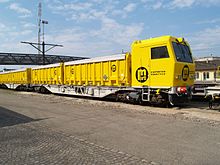CargoSprinter
| CargoSprinter Windhoff MPV |
|
|---|---|

modified Talbot vehicle for the Marti Express Shuttle (Switzerland)
|
|
| Manufacturer |
Windhoff also Waggonfabrik Talbot |
| Constructed | 1996- |
| Cargo Sprinter (DB class 690) Talion (DB Class 691) |
|
|---|---|
| Manufacturer | DB 690: Windhoff DB 691: Waggonfabrik Talbot |
| Entered service | 1996/7 |
| Number built | DB 690 : 3 DB 691 : 4 |
| Specifications | |
| Train length | DB 690 : 90.360m DB 691 : 89.570m |
| Car length |
motor/control car DB 690 : 20.190m DB 691 : 19.740m |
| Floor height | 1130 - 1180mm |
| Maximum speed | 120km/h with 112t load (75 MPH) |
| Weight | DB 690 : 121 tonnes DB 691 : 113 tonnes |
| Prime mover(s) | four 265kW engines |
| Transmission | 5 speed mechanical, with torque converter and retarder |
| UIC classification |
DB 690 : 1Ao'Ao1'+2+2+2+1Ao'Ao1' DB 691 : 1Ao'Ao1'+2'(2')(2')2'+1Ao'Ao1' |
| Braking system(s) | Disc, all axles |
| Multiple working | Yes |
The CargoSprinter is a freight multiple unit designed to transport freight or equipment. The CargoSprinter was designed by Windhoff GmbH (Germany) in the mid-1990s.
Initially seven vehicles were built for Deutsche Bahn. Four were built by Windhoff and had the reporting code DB class 690. Another three closely similar units were built by Waggonfabrik Talbot ('Talbot Talion') and given the reporting code DB class 691. The design did not lead to further freight work, several of the trains were later converted for other uses including tunnel rescue trains.
A variant for infrastructure and service trains, named the Multi Purpose Vehicle has been sold to a number of countries, mainly for use by rail infrastructure companies, including the United Kingdom (Railtrack; track maintenance and specialised overhead electrification train), Switzerland (specialised tunnel rescue and firefighting version), and the Netherlands and Taiwan (maintenance of high speed lines).
The CargoSprinter was developed in 1996 by Windhoff in association with freight operators DB Cargo and Fraport. The concept was for a self powered container carrying freight train, with a relatively high top speed enabling it to operate without disrupting passenger services. The train was a five-car permanently connected set of container-carrying vehicles (capacity ~10TEU), with driving cab at each end (motorised with underfloor engines), and capable of being easily connected and worked in multiple with other CargoSprinter trains. The original designs were taken from concept stage to production in 12 months.
The new concept was optimistically received as offering a step change in rail freight transportation, allowing rapid efficient transport of less than trainload and shortline freight, 7 vehicles were initially built (1997) for trials with Deutsche Bahn. In practice the CargoSprinter concept was not a success as a commercial freight vehicle, trials of the vehicles did not lead to regular work. Ex-freight trial vehicles later found use modified for specialised roles, such as tunnel rescue, and hybrid powered freight trains.
...
Wikipedia
